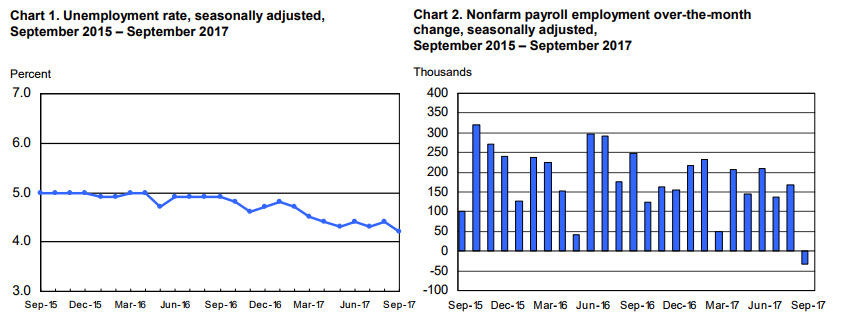Lost in Space” is the title of a 1965 TV Series that is being remade and released for the 2018 season. “Lost in FOMC Space” could have been the title for the Federal Open Market Committee minutes of the September 19-20 meeting.
The issue is inflation. The Committee members are totally bamboozled by its stubbornly low level.
Some believe the low readings are due to “idiosyncratic or one-time factors, and, thus, their effects were likely to fade over time.”
Others believe the low readings may be due to “secular trends, such as the influence of technological innovations on competition and business pricing, also might have been muting inflationary pressures and could be intensifying.
Several participants noted that persistence of low rates of inflation might imply that the underlying trend was running below 2 percent, risking a decline in inflation expectations.
The minutes noted that “other advanced economies were also experiencing low inflation, which might suggest that common global factors could be contributing to persistence of below-target inflation in the United States and abroad.”
Neel Kashkari, the Minneapolis Fed President, believes the Fed’s rate hikes are the cause of the persistently low inflation. He thinks rates should not rise again until core PCE (personal consumption expenditures) reaches “2% on a 12-month basis unless we see a large drop in the headline unemployment rate.”
In the FOMC’s September 2017 Summary of Economic Projections, Committee participants’ estimates of the longer-run normal rate of unemployment ranged from 4.4 to 5.0 percent and had a median value of 4.6 percent.
On October 6, the US Bureau of Labor Statistics reported that the unemployment rate was 4.2%.
If the current employment rate is 4.2% and the FOMC’s median value is 4.6%, the US could be considered to have achieved “full-employment. Except, full-employment is not a number, just a concept.
Chart: US unemployment rate and Nonfarm payrolls
And there lies the problem.
The theory goes something like once full employment has been reached, new hires can only be found by raising wages to attract employees from other companies, eventually resulting in higher prices or inflation.
The US may be at “full-employment,” but price pressures aren’t evident.
The FOMC makes a habit of telling markets that rate moves are data dependent. Their exact words are “the actual path of the federal funds rate would depend on the economic outlook as informed by incoming data.”
However, they also said that the Hurricanes would affect the quarterly patterns of changes in real GDP, at least through the second half of the year.
That raises the question: If the Fed is data dependent and the data they depend on is distorted, why would they continue to forecast one more rate increase in 2017?
The FOMC being Lost in FOMC Space is just one dilemma facing FX markets. What happens if the spaceship gets a new Captain?
Last week, US dollar selling occurred when a report surfaced that Fed member Jerome Powell was being touted as the next Chair of the Fed. The story was rehashed on October 11 which added to US dollar selling pressures.
That story and the release of the FOMC minutes led to broad US dollar selling. The Canadian dollar was a big beneficiary of the move but there were other factors at play.
A key factor was President Trump. The president offered up the possibility of a Canada/US bilateral trade agreement if the NAFTA negotiations fail.
It appears that failure is his preferred outcome. He continually tells everyone who will listen that it is “possible that we won’t reach a deal.” Last week, while supposedly honoring the Stanley Cup Champions, he asked Pittsburg Penguin co-owner Ron Burkle to “get involved negotiating NAFTA.” These aren’t the actions of a man dealing in good faith.
Round four of the trilateral treaty starts next week, and even Canada’s Prime Minister Justin Trudeau appears resigned to the fact that failure is an option.
Failure is also an option in the UK. Talks between the European Union and the United Kingdom are deadlocked. Prime Minister Theresa May said that Britain would honour financial commitments.
EU chief negotiator Michel Barnier said her remarks were fine but wants her to “show me the money.” Britain has not told the EU how much they are willing to pay leading Mr. Barnier to state “on this question, we have reached a state of deadlock which is very disturbing for thousands of project promoters in Europe and it’s disturbing also for taxpayers.”
It remains to be seen which are the more difficult negotiations. Canada and Mexico dealing with President Trump and his administration or Great Britain dealing with the 27 member states of the European Union
Fed Chair Janet Yellen and the FOMC probably prefer being ‘Lost in Space” to Tip-toeing through a trade negotiation mine-field of Tulips.







